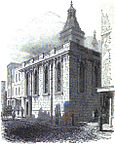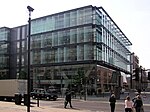St Peter, Paul's Wharf

St Peter, Paul's Wharf, was a Church of England parish church in the City of London. It was destroyed in the Great Fire in 1666.First mentioned in the 12th Century It stood to the north of Upper Thames Street in Queenhithe Ward The parish was defiant in continuing to use the Book of Common Prayer during the Civil War.St Peter's was, along with most of the City's other parish churches, destroyed by the Great Fire in 1666. A Rebuilding Act was passed and a committee set up under Sir Christopher Wren to decide which would be rebuilt. Fifty-one were chosen, but St Peter Paul's Wharf was not among them. Following the fire, the parish was united with that of St Benet Paul's Wharf.
Excerpt from the Wikipedia article St Peter, Paul's Wharf (License: CC BY-SA 3.0, Authors, Images).St Peter, Paul's Wharf
Godliman Street, City of London
Geographical coordinates (GPS) Address Nearby Places Show on map
Geographical coordinates (GPS)
| Latitude | Longitude |
|---|---|
| N 51.51237 ° | E -0.0988 ° |
Address
Godliman Street 21
EC4V 5BD City of London
England, United Kingdom
Open on Google Maps










